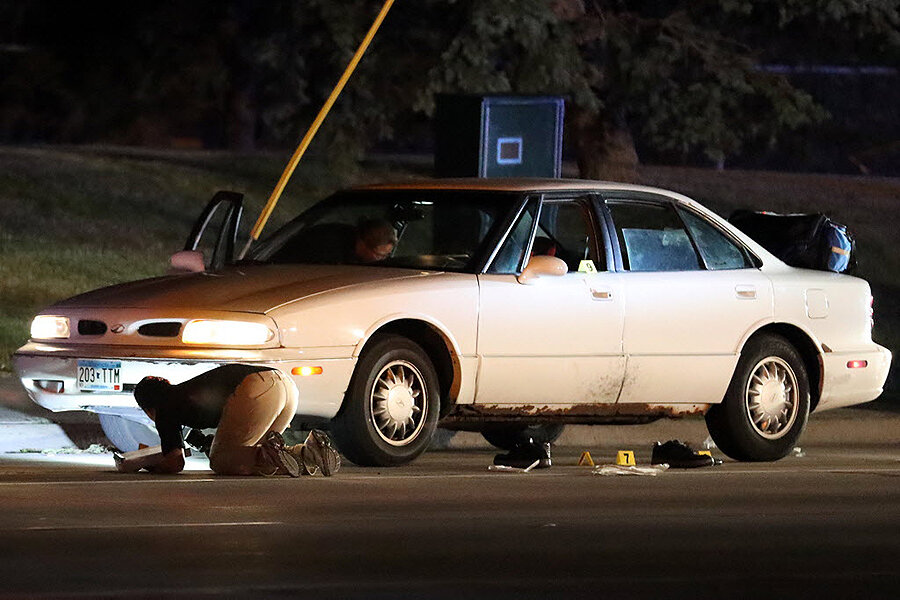Minnesota man shot as police use of force retakes the spotlight
Loading...
Protests quickly followed after police shot a black man at a traffic stop in St. Paul, Minn., on Wednesday night, during a week when questions over police force against minorities returned to the forefront of national attention.
The man, identified by the Minneapolis Star Tribune as Philando Castile, died in a hospital later on Wednesday night. Relatives and friends of Mr. Castile held a prayer vigil in front of the hospital, and protesters gathered peacefully at the scene of the incident and at the Minnesota governor's residence, chanting anti-police slogans and demanding action from the governor.
Although its authenticity has yet to be verified, a video posted to Facebook shows Castile's girlfriend speaking to the camera beside a man wearing a bloody shirt. The woman tells an officer with a drawn gun that he shot her boyfriend while he was reaching for his wallet to show his license to carry a handgun.
The officer "shot him for no apparent reason, no reason at all," she says on video.
Relatives said Castile had worked in the cafeteria of a St. Paul public school for at least 12 years, and the Star Tribune reported he had only misdemeanors on his record.
"The family has a number of concerns about what happened in this case," Nekima Levy-Pounds, president of the Minneapolis NAACP chapter, told the Star Tribune. "They do not believe that the shooting was warranted in this case. Philando Castile was an upstanding citizen, according to all the reports that we've heard."
Police confirmed that a handgun was recovered from the scene and the Minnesota Bureau of Criminal Apprehension will lead an investigation. The interim police chief said the St. Anthony police area had not seen an officer-involved shooting in 30 years.
"It's shocking," St. Anthony Police Sgt. Jon Mangseth told the Star Tribune. "It's not something that occurs here in our area."
Questions about police relations with minorities grabbed attention around the nation on Tuesday, when a video-recording showing the police shooting another black man incited protests in Baton Rouge, La. Two white officers had pinned Alton Sterling to the ground and shot him after responding to a call that Mr. Sterling, who had several criminal convictions and had spent nearly four years in jail as a sex offender, had threatened someone with a gun.
Roughly 300 relatives of Alton Sterling and other protesters demonstrated peacefully outside the convenience store where he was shot early on Thursday, calling for unity and justice for the community's black residents.
"There is not going to be a riot until they show they are not going to prosecute these people," Arsby, a protester and truck driver who declined to give his last name, told Reuters. "Right now it's just started."
After the governor of Louisiana called for a Justice Department probe, the department announced Wednesday it would investigate Sterling's death, an unusually quick response. Some say the rapid investigation points to lessons learned, even as other protesters doubt the integrity of a federal probe, as The Christian Science Monitor's Jessica Mendoza and Story Hinckley reported:
Still, the governor’s call for an investigation is just the beginning. The true test of whether or not change is coming is what happens next: How thorough will the investigation be? Will anyone be prosecuted? And will the presence of an independent agency become a fixture in these cases, instead of something that top-ranking officials call for ad hoc?
The protesters are calling for justice, but the immediate process of investigation suggests police jobs are becoming "more transparent and accountable" as lessons are learned, Jody Armour, a professor of law who specializes in criminal and racial justice at the University of Southern California, told the Monitor.
"We're in the middle of what may be a transformation in the relationship between citizens and the police department in matters of transparency and accountability," he said. "The governor's proactive steps in this case may be a part of that new pattern that's emerging in which law enforcement leaders and political leaders realize it's more important to get in front of a story rather than play catch-up. This suggests that a difference is being made."
This report contains material from the Associated Press and Reuters.








